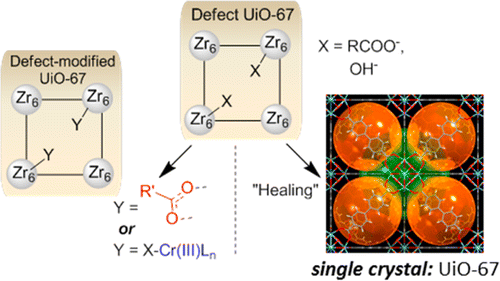For three-dimensional (3D) metal–organic frameworks (MOFs), the presence and nature of structural defects has been recognized as a key factor shaping the material’s physical and chemical behavior. In this work, the formation of the “missing linker” defects has been addressed in the model biphenyl-4,4′-dicarboxylate (bpdc)-based Zr MOF, UiO-67. The defect showed strong dependence on the nature of the modulator acid used in the MOF synthesis; the defects, in turn, were found to correlate with the MOF physical and chemical properties. The dynamic nature of the Zr6 (node)-monocarboxylate bond showed promise in defect functionalization and “healing”, including the formation of X-ray-quality “defect-free” UiO-67 single crystals. Chemical transformations at defect sites have also been explored. The study was also extended to the isoreticular UiO-66 and UiO-68′ systems.
